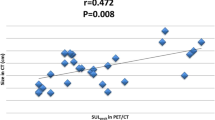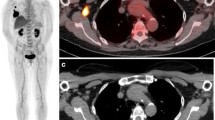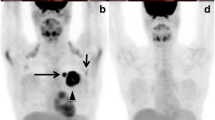Abstract
Fluorine-18 fluorodeoxyglucose positron emission tomography/computed tomography (18F-FDG PET/CT) is currently used in daily clinical practice for the evaluation of breast cancer (BC) patients. This chapter provides an overview of the current evidence-based data on the usefulness of PET/CT (using 18F-FDG and other radiotracers) for different indications in patients with BC.
You have full access to this open access chapter, Download chapter PDF
Similar content being viewed by others
1 Introduction
Fluorine-18 fluorodeoxyglucose positron emission tomography/computed tomography (18F-FDG PET/CT) is currently used in daily clinical practice for the evaluation of breast cancer (BC) patients. This chapter provides an overview of the current evidence-based data on the usefulness of PET/CT (using 18F-FDG and other radiotracers) for different indications in patients with BC.
2 Staging
A recent network meta-analysis comparing 19 different imaging methods demonstrated the relatively higher specificity of 18F-FDG PET/CT compared to other imaging methods for the detection of BC lesions [1].
Liang et al. [2] evaluated through a meta-analytic approach the accuracy of magnetic resonance imaging (MRI) and 18F-FDG PET/CT for lymph nodal (N) staging of early BC. The pooled specificities of MRI and PET/CT for diagnosing regional lymph nodal status in BC patients were similar (93%); however, the pooled sensitivity of MRI was significantly greater than PET/CT (82% versus 64%), respectively.
Hong et al. [3] performed a meta-analysis to evaluate the value of 18F-FDG PET/CT for diagnosis of distant metastases of BC. Pooled sensitivity and specificity of 18F-FDG PET/CT were 96% (95%CI: 90–98%) and 95% (95%CI: 92–97%), respectively. Compared with conventional imaging, 18F-FDG PET/CT has higher sensitivity for diagnosis of distant metastases in BC patients.
Similar findings were reported in another meta-analysis by Sun et al. [4]: pooled sensitivity and specificity of 18F-FDG PET or PET/CT were 99% (95%CI: 88–100%) and 95% (95%CI: 89–98%), respectively, confirming the excellent diagnostic performance of 18F-FDG PET/CT for distant metastasis staging in BC patients compared to conventional imaging.
Rong et al. [5] found that the pooled sensitivity and specificity of 18F-FDG PET/CT for detecting bone metastases of BC were 93% (95%CI: 82–98%) and 99% (95%CI: 95–100%), respectively. Compared with bone scintigraphy, 18F-FDG PET/CT has higher sensitivity and accuracy for detection of bone metastases in BC patients.
3 Restaging and Assessment of Response to Neoadjuvant Therapy
Evangelista et al. [6] performed a meta-analysis on the use of tumour markers in BC patients as a guide for 18F-FDG PET imaging. The meta-analysis provided the following results: pooled sensitivity 87.8% (95%CI: 83.8–90.9%) and pooled specificity 69.3% (95%CI: 55.3–80.5%), confirming the role of 18F-FDG PET/CT in detecting metastases in the presence of a progressive increase of serum tumour markers in BC patients.
Xiao et al. [7] found that the pooled sensitivity and specificity of 18F-FDG PET or PET/CT in detecting BC recurrence were 90% (95%CI: 88–90%) and 81% (95%CI: 78–84), respectively. Therefore, 18F-FDG PET/CT is a valuable imaging method to detect relapse in suspected recurrent BC patients.
Several meta-analyses evaluated the usefulness of 18F-FDG PET/CT in predicting the response to neoadjuvant therapy in BC patients. According to Wang et al. [8], the pooled sensitivity, specificity, positive predictive value (PPV) and negative predictive value (NPV) of 18F-FDG PET/CT in this setting were 84% (95%CI: 78–88%), 66% (95%CI: 62–70%), 50% (95%CI: 44–55%) and 91% (95%CI: 87–94%), respectively. For regional lymph nodes, sensitivity and NPV of 18F-FDG PET/CT were 92% (95%CI: 83–97%) and 88% (95%CI: 76–95%), respectively. Overall, 18F-FDG PET/CT is useful to predict neoadjuvant therapy response in BC patients, but the relatively low specificity and PPV still call for caution. Cheng et al. [9] found similar results of 18F-FDG PET/CT in this setting reporting a pooled sensitivity and specificity of 84.7% (95%CI: 79.3–89.2%) and 66.1% (95%CI: 59.8–72.0%), respectively, indicating that 18F-FDG PET/CT has reasonable sensitivity in evaluating response to neoadjuvant chemotherapy in BC, but the specificity is relatively low. Mghanga et al. [10] found that 18F-FDG PET has moderately high sensitivity (80.5%; 95%CI: 75.9–84.5%) and specificity (78.8%; 95%CI: 74.1–83.0%) in early detection of responders from nonresponders, and it can be used for the evaluation of response to neoadjuvant chemotherapy in BC patients. Another meta-analysis [11] reported that the pooled sensitivity and specificity of 18F-FDG PET/CT in this setting were 81.9% (95%CI: 76.0–86.6%) and 79.3% (95%CI: 72.1–85.1%), respectively, confirming the moderate accuracy of 18F-FDG PET/CT in predicting neoadjuvant therapy response in BC patients.
Several meta-analyses compared 18F-FDG PET/CT and MRI for evaluation of treatment response to neoadjuvant chemotherapy (NAC) in BC patients. Liu et al. [12] reported that 18F-FDG PET/CT has a higher sensitivity and MRI has a higher specificity in assessing pathological complete response (pCR) after NAC in BC patients. The pooled sensitivity and specificity of 18F-FDG PET/CT were 86% (95%CI: 76–93%) and 72% (95%CI: 49–87%), respectively. Therefore, the combined use of these two imaging modalities may have great potential to improve the diagnostic performance in assessing pCR after NAC. Another meta-analysis [13] indicates that the timing of imaging for NAC-response assessment exerts a major influence on the estimates of diagnostic accuracy: 18F-FDG PET/CT outperformed MRI in intra-NAC assessment, whereas the overall performance of MRI was higher after completion of NAC, before surgery. The pooled estimates of sensitivity and specificity were 71% and 77% for 18F-FDG PET/CT and 88% and 55% for MRI, respectively. Chen et al. [14] found that the diagnostic performance of MRI is similar to that of 18F-FDG PET/CT for the assessment of BC response to NAC. For 18F-FDG PET/CT, the pooled sensitivity was 87% (95%CI: 71–95%) and pooled specificity was 85% (95%CI: 70–93%). For MRI, the pooled sensitivity was 79% (95%CI: 68–87%) and the pooled specificity was 82% (95%CI: 72–89%). However, 18F-FDG PET/CT is more sensitive than conventional contrast-enhanced MRI and more specific if the second imaging scan is performed before three cycles of NAC. Lastly, Li et al. [15] found that MRI had a higher sensitivity and 18F-FDG PET/CT had a higher specificity in predicting the pathologic response after NAC in patients with BC, with similar accuracy among the two methods. The pooled sensitivity and specificity of MRI were 88% (95%CI: 78–94%), and 69% (95%CI: 51–83%), respectively. The corresponding values for 18F-FDG PET/CT were 77% (95%CI: 58–90%) and 78% (95%CI: 63–88%), respectively.
4 Prognostic Value
Diao et al. [16] evaluated the prognostic value of maximum standardized uptake values (SUVmax) measured in the primary lesion and axillary lymph nodes (ALN) by pretreatment 18F-FDG PET or PET/CT in patients with BC. For event-free survival (EFS), patients with higher SUVmax in primary tumour and ALN showed a poorer prognosis with pooled hazard ratio (HR) of 1.96 (95%CI: 1.40–2.73) and 1.89 (95%CI: 0.70–5.07), respectively. In analysing invasive ductal carcinoma (IDC) patients, the pooled HR was 1.91 (95%CI: 1.40–2.64). For overall survival (OS), the pooled HR of SUVmax in primary lesion and ALN were 0.64 (95%CI: 0.23–1.84) and 1.09 (95%CI 0.07–16.53), respectively. Therefore, patients with BC and higher SUVmax in primary lesion or ALN may experience a higher risk for recurrence or a poor progression.
5 Incidental 18F-FDG Uptake
A meta-analysis calculated the prevalence and clinical significance of breast incidental 18F-FDG uptake (BIU) detected by PET or PET/CT in patients performing PET for other reasons than BC evaluation [17]. The pooled prevalence of BIU on all PET scans was 0.4% (95%CI: 0.23–0.61%), the pooled prevalence on PET scans on female patients only was 0.82% (95%CI: 0.51–1.2%), the pooled risk of malignancy of BIU when further evaluated was 48% (95%CI: 38–58%) and the pooled risk of malignancy of BIU with histological examination was 60% (95%CI: 53–66%). Despite being uncommon, the identification of BIU frequently signals the presence of an unsuspected subclinical lesion and the risk of malignancy is very high.
6 18F-FDG Positron Emission Mammography
The diagnostic performance of dedicated 18F-FDG positron emission mammography (PEM) in evaluating suspicious BC has been investigated by a meta-analytic study [18]: pooled sensitivity and specificity of 18F-FDG PEM in women with suspected breast malignancy were 85% (95%CI: 83–88%) and 79% (95%CI: 74–83%), respectively, on a per-lesion-based analysis. The detection of additional breast lesions and extensive intraductal involvement is improved by PEM, with comparable accuracy over that of MRI in the depiction of invasive BC.
7 PET/MRI
Lin et al. [19] performed a meta-analysis to assess the staging/restaging performance of hybrid 18F-FDG PET/MRI in BC patients. The pooled sensitivity and specificity of 18F-FDG PET/MRI for staging/restaging BC were 98% (95%CI: 95–99%) and 87% (95%CI: 76–95%), respectively, on a per-patient analysis and 91% (95%CI: 88–94%) and 95% (95%CI: 92–97%), respectively, on a per-lesion analysis. Overall, 18F-FDG PET/MRI has excellent diagnostic performance in staging/restaging BC patients.
8 Other PET Tracers Beyond 18F-FDG
Evangelista et al. [20] assessed the role of 18F-fluoroestradiol (18F-FES) PET in patients with BC. A pooled sensitivity of 82% (95%CI: 74–88%) and a pooled specificity of 95% (95%CI: 86–99%) for the evaluation of oestrogen receptor status in BC by 18F-FES PET were found, demonstrating a good accuracy of this method in this setting. Conversely, the pooled sensitivity and specificity of 18F-FES PET in predicting the response to hormonal therapy in patients with locally advanced or metastatic BC were unsatisfactory.
Deng et al. [21] evaluated the diagnostic performance of 18F-fluorothymidine (18F-FLT) PET and PET/CT for evaluating the response to chemotherapy in patients with BC. The pooled sensitivity and specificity of 18F-FLT PET in this setting were 77.3% (95%CI: 59.4–90%) and 68.5% (95%CI: 47.9–84.9%), respectively, with a moderate diagnostic accuracy.
References
Zhang XH, Xiao C. Diagnostic value of nineteen different imaging methods for patients with breast cancer: a network meta-analysis. Cell Physiol Biochem. 2018;46(5):2041–55.
Liang X, Yu J, Wen B, Xie J, Cai Q, Yang Q. MRI and FDG-PET/CT based assessment of axillary lymph node metastasis in early breast cancer: a meta-analysis. Clin Radiol. 2017;72(4):295–301.
Hong S, Li J, Wang S. 18FDG PET-CT for diagnosis of distant metastases in breast cancer patients. A meta-analysis. Surg Oncol. 2013;22(2):139–43.
Sun Z, Yi YL, Liu Y, Xiong JP, He CZ. Comparison of whole-body PET/PET-CT and conventional imaging procedures for distant metastasis staging in patients with breast cancer: a meta-analysis. Eur J Gynaecol Oncol. 2015;36(6):672–6.
Rong J, Wang S, Ding Q, Yun M, Zheng Z, Ye S. Comparison of 18 FDG PET-CT and bone scintigraphy for detection of bone metastases in breast cancer patients. A meta-analysis. Surg Oncol. 2013;22(2):86–91.
Evangelista L, Cervino AR, Ghiotto C, Al-Nahhas A, Rubello D, Muzzio PC. Tumor marker-guided PET in breast cancer patients-a recipe for a perfect wedding: a systematic literature review and meta-analysis. Clin Nucl Med. 2012;37(5):467–74.
Xiao Y, Wang L, Jiang X, She W, He L, Hu G. Diagnostic efficacy of 18F-FDG-PET or PET/CT in breast cancer with suspected recurrence: a systematic review and meta-analysis. Nucl Med Commun. 2016;37(11):1180–8.
Wang Y, Zhang C, Liu J, Huang G. Is 18F-FDG PET accurate to predict neoadjuvant therapy response in breast cancer? A meta-analysis. Breast Cancer Res Treat. 2012;131(2):357–69.
Cheng X, Li Y, Liu B, Xu Z, Bao L, Wang J. 18F-FDG PET/CT and PET for evaluation of pathological response to neoadjuvant chemotherapy in breast cancer: a meta-analysis. Acta Radiol. 2012;53(6):615–27.
Mghanga FP, Lan X, Bakari KH, Li C, Zhang Y. Fluorine-18 fluorodeoxyglucose positron emission tomography-computed tomography in monitoring the response of breast cancer to neoadjuvant chemotherapy: a meta-analysis. Clin Breast Cancer. 2013;13(4):271–9.
Tian F, Shen G, Deng Y, Diao W, Jia Z. The accuracy of 18F-FDG PET/CT in predicting the pathological response to neoadjuvant chemotherapy in patients with breast cancer: a meta-analysis and systematic review. Eur Radiol. 2017;27(11):4786–96.
Liu Q, Wang C, Li P, Liu J, Huang G, Song S. The role of (18)F-FDG PET/CT and MRI in assessing pathological complete response to neoadjuvant chemotherapy in patients with breast cancer: a systematic review and meta-analysis. Biomed Res Int. 2016;2016:3746232.
Sheikhbahaei S, Trahan TJ, Xiao J, Taghipour M, Mena E, Connolly RM, et al. FDG-PET/CT and MRI for evaluation of pathologic response to neoadjuvant chemotherapy in patients with breast cancer: a meta-analysis of diagnostic accuracy studies. Oncologist. 2016;21(8):931–9.
Chen L, Yang Q, Bao J, Liu D, Huang X, Wang J. Direct comparison of PET/CT and MRI to predict the pathological response to neoadjuvant chemotherapy in breast cancer: a meta-analysis. Sci Rep. 2017;7(1):8479.
Li H, Yao L, Jin P, Hu L, Li X, Guo T, et al. MRI and PET/CT for evaluation of the pathological response to neoadjuvant chemotherapy in breast cancer: a systematic review and meta-analysis. Breast. 2018;40:106–15.
Diao W, Tian F, Jia Z. The prognostic value of SUVmax measuring on primary lesion and ALN by 18F-FDG PET or PET/CT in patients with breast cancer. Eur J Radiol. 2018;105:1–7.
Bertagna F, Treglia G, Orlando E, Dognini L, Giovanella L, Sadeghi R, et al. Prevalence and clinical significance of incidental F18-FDG breast uptake: a systematic review and meta-analysis. Jpn J Radiol. 2014;32(2):59–68.
Caldarella C, Treglia G, Giordano A. Diagnostic performance of dedicated positron emission mammography using fluorine-18-fluorodeoxyglucose in women with suspicious breast lesions: a meta-analysis. Clin Breast Cancer. 2014;14(4):241–8.
Lin CY, Lin CL, Kao CH. Staging/restaging performance of F18-fluorodeoxyglucose positron emission tomography/magnetic resonance imaging in breast cancer: a review and meta-analysis. Eur J Radiol. 2018;107:158–65.
Evangelista L, Guarneri V, Conte PF. 18F-Fluoroestradiol positron emission tomography in breast cancer patients: systematic review of the literature & meta-analysis. Curr Radiopharm. 2016;9(3):244–57.
Deng SM, Zhang W, Zhang B, Wu YW. Assessment of tumor response to chemotherapy in patients with breast cancer using (18)F-FLT: a meta-analysis. Chin J Cancer Res. 2014;26(5):517–24.
Author information
Authors and Affiliations
Corresponding author
Editor information
Editors and Affiliations
Rights and permissions
Open Access This chapter is licensed under the terms of the Creative Commons Attribution 4.0 International License (http://creativecommons.org/licenses/by/4.0/), which permits use, sharing, adaptation, distribution and reproduction in any medium or format, as long as you give appropriate credit to the original author(s) and the source, provide a link to the Creative Commons license and indicate if changes were made.
The images or other third party material in this chapter are included in the chapter's Creative Commons license, unless indicated otherwise in a credit line to the material. If material is not included in the chapter's Creative Commons license and your intended use is not permitted by statutory regulation or exceeds the permitted use, you will need to obtain permission directly from the copyright holder.
Copyright information
© 2020 The Author(s)
About this chapter
Cite this chapter
Treglia, G. (2020). Evidence-Based PET for Breast Cancer. In: Treglia, G., Giovanella, L. (eds) Evidence-based Positron Emission Tomography. Springer, Cham. https://doi.org/10.1007/978-3-030-47701-1_6
Download citation
DOI: https://doi.org/10.1007/978-3-030-47701-1_6
Published:
Publisher Name: Springer, Cham
Print ISBN: 978-3-030-47700-4
Online ISBN: 978-3-030-47701-1
eBook Packages: MedicineMedicine (R0)




